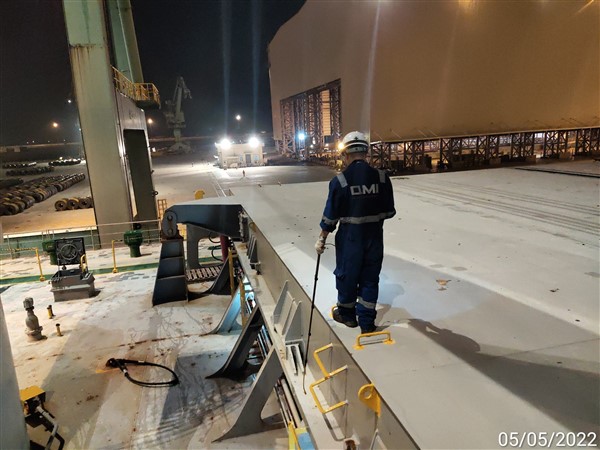ULTRASONIC HATCH COVER CHECKING
Tightness of hatch covers
Approximately one third of all P&I claims are cargo-related. A significant portion of cargo claims is caused by water damage, of which numerous cases relate to ingress of sea water via the hatch covers of dry cargo vessels. Reports of leaking hatch covers are the most frequent cause for selecting a vessel for an unscheduled condition survey.
There are mainly three different ways to test hatch cover tightness, and they all have some pros and cons.
- The chalk test is often carried out when the vessel is new, in the shipyard. All compression bars are rubbed with a piece of chalk, thereafter the hatch covers are put in place and secured, and then opened again. If there has been insufficient compression between the compression bar and the hatch cover gasket, there will be a lack of or incomplete chalk marks on such areas of the gasket. The advantage of this test method is that one can see exactly where the problem is. Also, it is clearly seen from the chalk marks if the gasket lands off-centre on the compression bar. The disadvantage is that one needs quite a bit of chalk, which is normally not found on board. The method is rather time-consuming, and it can only be used in dry weather.
- The hose test is the traditional way of testing hatch covers. It is easy to carry out, and the crew can do the job. It is inexpensive, as a fire hose with a nozzle and good water pressure from the fire pump is all that is needed. It can be useful to have good results of hatch cover tests entered in the log book. Some of the disadvantages of the hose test are that it sometimes becomes just a lot of messing around with water and it is not recommended to be carried out on loaded vessels – more than once the hose test itself has caused water damage to cargo. Good water pressure is needed, but not always produced, and of course the test can not be used if temperatures fall below zero.
- The latest and most accurate way of testing hatch covers is by using an ultrasonic apparatus. A unit emitting ultrasound is placed inside the cargo hold and the operator registers “leakages” of ultrasound through the hatch covers using a handled detector. Normally one will first measure “open hatch” values and establish 10 per cent of such as the lower acceptable limit with hatch covers closed down. The ultrasonic test method is easily carried out by a hired operator, and the location and importance of leakages are clearly identified in his report. The method has the great advantage that it can also be used on loaded vessels, by placing the transmitter on top of the cargo. Another advantage is that it can be used in cold weather. Major steel exporters may require satisfactory ultrasonic tests carried out on all ships, to reduce risk of damage to cargo. A satisfactory ultrasonic test, correctly documented by the professional operator, will carry some weight if a dispute about hatch cover condition should arise.

